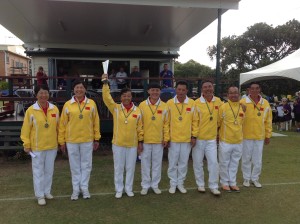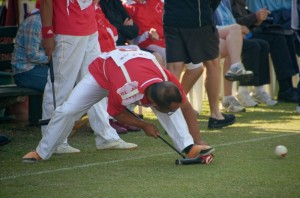Keith McLeod has submitted some valuable observations on tactics from this year’s Australian Championships. Gateball Australia thanks Keith for his comments and asks players to make comments on Keith’s observations. You can do this underneath Keith’s article.
 The 2015 Australian Gateball Championship – And Why the Chinese Teams Won!
The 2015 Australian Gateball Championship – And Why the Chinese Teams Won!
One good thing about being Tournament Referee is that I had an opportunity to observe many games, although some very briefly.
I noted the Chinese teams’ comfortable progression through the block games with only two losses (well done McIlwraith and NSW Country). So how is it that these Gateballers are so much better than our teams? Let me share my thoughts and observations.
Player Skills
Although many Asian players play golf style, the Chinese use centre style but with rather unique features:
- the stance is with both feet close together and there is no stalking;
- the head of the stick is usually in contact with at least one shoe; and
- the stroke is very hammer like with little backswing and minimum follow through.
Using this style, they have developed a high level of Touch accuracy. Also, this style appears to assist with achieving successful slide touches, but more on this later.
 To get precise sparking accuracy, most Chinese players bent low over the set balls with the right foot well back from the set (for right handed players). This enabled them to sight the set direction accurately. The overall precision of their sparking contributed significantly to their success. (Any Aussie Gateballer who has received coaching from me will know I always stress that effective sparking is the secret of Gateball success….and the Chinese certainly proved that).
To get precise sparking accuracy, most Chinese players bent low over the set balls with the right foot well back from the set (for right handed players). This enabled them to sight the set direction accurately. The overall precision of their sparking contributed significantly to their success. (Any Aussie Gateballer who has received coaching from me will know I always stress that effective sparking is the secret of Gateball success….and the Chinese certainly proved that).
When attempting a sparking bombard, the direction precision achieved by the low sparking stance certainly pays off. Successful bombards by the Chinese were the rule and not the exception.
Aussie players seem content to gently stroke an out-ball into the court often with their ball finishing up to 200mm from the line, or to stroke it to an exposed position on the court so that it is easy for the opponent team to attack. The Chinese made sure that their ball was just on the line and often with part of the ball outside the court thus making good use of the painted court lines.
I saw some exceptional slide touches and a few with the target ball to be touched at least 1m away from the stroker’s ball!! From my observations, this was one of their key skills. During a recent practice, I tried slide touches using the Chinese stance (feet close and one shoe used to guide the stick head) and a very short backswing, then a hammer stroke on the stroker’s ball. It worked well and with some practice, I think I could become more proficient with slide touches using this technique.
Game Strategy and Tactics
Some of the strategies and tactics used with success by the Chinese that I noted were:
- holdback tactics used every game;
- often only 1 or 2 balls on the court in the first round;
- holdback, place a ball at the back of G1, then make G1 and slide touch to G2 (affectionately known by the Aussie teams at the 2010 World Gateball Championship as the ‘Shanghai holdback’);
- content to win without seeking high scores (note the semi and final scores);
- Gate and Touch tactic was used often; I saw some Aussie teams fail to capitalise on Gate and Touch opportunities;
- a tactic that was new to me was sparking an opponent ball to a team ball to make a subsequent bombard easier; ingenious, however it requires high confidence in sparking depth;
- using opponent balls instead of sparking them to out-balls; and
- using a team ball to bombard a critical opponent ball.
I hope we can all learn from the Chinese and improve our skills and tactics.
Keith McLeod


yes…..i agree wt u sir..they spark bowl very well and placement is very goo
spot on Keith we need to practice more
Thanks Keith for the observations. I’m new to the game but can understand clearly the tactics you discuss. I agree that sparking accurately is the crux of the game including bombarding and using the opponent tactically, not always trying to make them outballs.
I was particularly interested in the ploy of winning by not going after a high score but, instead, making sure the opponents were nullified by sparking them out of the game.
Cheers
Dennis (NZ)
Agree with the tactics. Not sure if I could master their stance though!
I wonder how long they have been playing and how often they play
Thanks for the interesting analysis Keith.
I think our Aussie teams can do a few things like keeping some balls off in the first couple of rounds, keeping tight to the line and tapping out balls onto the line to make it more difficult for strong opposition to knock us off. Then if we can make our shots we can definitely compete.
I tried the Chinese sparking style this weekend with limited success but I will stick with it for a few weeks.
Tapping on tight was an important ingredient that enabled NSW Country to get a win against one of the Chinese teams. Playing red, tapping on the line and getting a couple of early points at Gate 2 gave the NSW team a base from which to snatch the game at the end. The Chinese team used held off balls far more effectively than NSW Country and gained control probably around the 10-15 min mark. Although the constant tap ons were attacked by the Chinese, they spent time attacking balls rather than racking up points. Eventually, they could not deal with all 5 balls on the line at some distance from each other. This provided opportunities for counter attack, ie a slide set up and a 3/4 cross court shot at a cluster. Both these attempts failed but a final opportunity to pass gate three, execute a short bombard and then score the goal pole cemented the win for NSW Country coming from one point behind.
All Keith’s ingredients for success were illustrated in this game, and, if it were to be played again, NSW Country would have wished to use holdback more effectively, tapped on a bit tighter and been more accurate when opportunities presented themselves.
I’ve often played in teams where other players don’t like to use hold back. Confidence can be dented! Can someone identify how hold back works ideally?